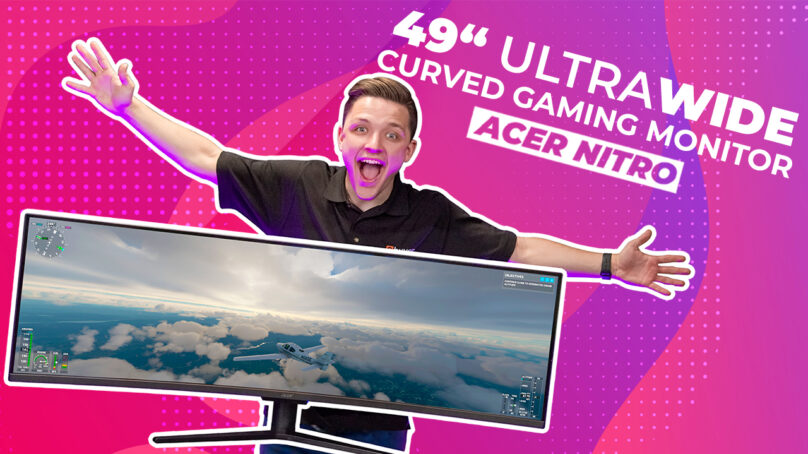
High refresh rate revolution
Over the years gaming monitors and their respective audience have evolved considerably. It wasn’t too long ago the majority or people chugged along, content with their admittedly bog-standard 1080p, 60HZ monitors.
Then, the high refresh rate revolution came. Now, 144Hz monitors are increasingly commonplace amongst game-likers, instead of exclusively reserved for top-tier e-athletes.
Technology industries – both hardware and software – have caught wind and adapted their approaches to accommodate user demands.
High refresh rate displays have even been integrated into smartphones, and games arbitrarily locked to 60FPS quickly become the laughing stock of gaming forums. Rightly so.
What’s next for gaming monitors?
Everybody’s seemingly agreed that high refresh rate displays are a straight-up beneficial upgrade. But what’s next? What’s going to be the next ‘must-have’ feature to push monitors forward?
Resolution is increasing, as always, though it isn’t exactly what gamers are looking for. They want ‘game-changing’ features – another predictable bump in resolution doesn’t address the situation.
Resolution vs. refresh rate
Especially since, for gamers, higher resolutions quickly hit diminishing returns. 8K is four times as many pixels as 4K, or sixteen times 1080p. This comes at the cost of exponentially growing hardware requirements. Is the perceivable difference between 4K and 8K worth devoting so much power to? Would you rather game at 8K, 30FPS or 4K, 120FPS?
After all, how many PC gamers are even running 4K monitors right now, never mind the inevitable 8K looming in the distance?
Taking a quick peek at the Steam Hardware Survey Results, less than 2.5% of users are reported to be running 3840×2160, commonly referred to as 4K. It’s clear the majority of gamers prefer refresh rate over resolution – or, more succinctly, experience over clarity.
The next frontier?
For a truly transformative experience, there’s currently an unforged path just waiting to be explored – ultrawide.
Online, there’s not too many of them, but they make themselves well known. A niche but strongly devout crowd of ultrawide evangelists lie in wait on the internet forums, ready to strike when an innocent ‘Which monitor should I buy?’ thread is posted.
They’ll go on seemingly endless tirades, proudly exclaiming the life-altering benefits an ultrawide monitor brings, “once you’ve gone ultrawide, you’ll never go back!”
But, are they wrong? Acer doesn’t think so, reenforcing the ultrawide cause by releasing their most convincing argument yet – the Acer Nitro 49-inch ‘Super’ ultrawide gaming monitor.
We’ve even covered other ultrawide monitors ourselves, like the LG 35WN65C 35-inch ultrawide QHD HDR VA monitor, hugely impress by it.
Super ultrawide
Wait, ‘super’ ultrawide? Yes, Acer is so confident in ultrawide that they’ve expanded the concept even further to fully exploit the form factor’s benefits.
To give some context, your ‘bog-standard’ monitor’s aspect ratio is 16:9, ultrawide’s 21:9, but super ultrawide pushes the boundaries to a frankly bonkers 32:9 aspect ratio. That’s enough for IMAX-style cinematic viewing.
At 49-inches, it’ll certainly take center stage, assertive in its dominance over your set-up. Though, it isn’t entirely unwieldy, with 15-degrees of tilt up, and 5-degrees tilt down.
It’s a single, contained unit. Gone are the days of awkwardly stitching multiple monitors together to achieve an inferior effect. This is an elegant, aesthetically pleasing solution.
To stop the monitor breaking free and escaping out of your field of view, it is curved at a comfortable 1800R angle, and engulfs you in the surrounding gameplay. The narrow-bezel design only enhances the experience.

Pushing the boundaries
This isn’t a standard 16:9 monitor stretched out, inheriting a primitive resolution. With 3840 pixels running along the horizontal resolution, details stay sharp across the board.
Despite pushing the boundaries of the ultrawide form factor, it doesn’t skimp on other features. The aforementioned high refresh rates are in full force here, with a respectable 120Hz right out of the box, but overclocking to a full-on 144Hz with ease.
The highest end iteration of FreeSync, FreeSync Premium Pro, is fully supported. Meaning, FreeSync remains operational, even with bandwith-sapping HDR enabled. Enjoy both HDR and low-latency gameplay, without compromises. Requiring an AMD graphics card, our AlphaSync systems are fully compatible.
Certified HDR
Unfortunately, HDR monitor support is at a weird in-between, at the moment. The technology is slowly but surely maturing, but in the meantime it’s like the wild-west out there in terms of falsified credentials.
Some will proudly proclaim HDR support, but in reality, it’s nothing more than another box-ticking feature. They barely even qualify as HDR in many cases, and enabling HDR produces a worse image quality than the ordinary SDR presentation. You’d be better leaving it off entirely.
Thankfully, VESA’s stepped up to introduce some standards going forward, and this monitor is VESA DisplayHDR 400 certified.
Even passing the base-level certification is a big deal, representing the first real introduction point to HDR, with true 8-bit image quality. It firmly puts this monitor in the top 15% of PC monitors today, meeting the minimum requirements for colour gamut and contrast to exceed a SDR presentation.

A profound gaming experience
Putting this all together – the 49-inch 32:9 presentation, 144Hz refresh rate and VESA DisplayHDR 400 certification – created one of the most positively overwhelming gaming experiences we’ve ever had.
Admittedly, it’s quite disorientating at first, being such a radical shift in the game’s presentation. But you’ll quickly settle in to a natural, blissful gaming experience.
What’s it like gaming on a super ultrawide monitor?
Focus in on your monitor. If it’s not an ultrawide, observe how little it occupies your field of view. Your peripheral vision is completely void.
Game developers go to extreme lengths to heighten the realism of their games, only to be wasted on an unrealistic form factor. The human eye doesn’t see in a boxy 16:9.
Game characters are no longer cramped into restrictive corners on an all-inclusive 32:9. They’re given room to breathe, and fully situate themselves within expansive game environments.
For a purely mechanical-focused take, 32:9 means more digestible on-screen information – whether that comes in the form of detecting enemies sneaking their way into your peripheral vision, or expanded space for maps and menus.
Annoying interferences like HUDs, indicators and notification pop-ups can be banished to the far corners of the monitor, letting you focus on the game itself.

Made for FPS and simulation games
Notably, in wildly popular first-person shooter games, the aspect ratio is a natural fit. Your view is no longer cramped, extending past the weapon model and capturing more of the environment for a truly immersive experience.
Lifting like curtains, finally see what’s always been there, obscured in conventional displays. In simulation titles the effects are especially profound, breathing new life into the complex systems.
Let’s highlight a specific title: Microsoft Flight Simulator. On a 16:9 display, it isn’t exactly a hassle-free experience, requiring constant panning and zooming around just to turn on the cabin lights.
On this Acer Nitro, the entire cockpit is laid out in plain view. An almost one-to-one recreation of the real deal, with the skies stretching out into the horizon all on one monitor.
Great outside of gaming
Film content is often produced in this aspect ratio, resulting in dreaded black bars above and below the images when viewed on 16:9 monitors.
So ultrawide monitors are ideal for watching cinematic content, as they produce the closest cinema-like experience. Paired up with the HDR support this monitor easily doubles up as a content consumption screen.
The benefits of a Super ultrawide presentation extend to productivity applications. Think of a multi-monitor set-up, without the downsides. No awkward colour-shifting inconsistent adjustments and bezels taking up precious space.
With three HDMI connections and one DisplayPort it’s possible to hook up multiple devices. The monitor supports both picture-in-picture and picture-by-picture, smartly dividing up the screen into dedicated quadrants for multi-functional use.

Is super ultrawide the next must-have feature?
After the initial shock factor regarding the sheer size of this imposing gaming monitor subsided, it was hard not come away overwhelmingly impressed. It enables brand-new experiences that truly transform gaming experiences. We’d seriously consider giving a super ultrawide monitor a shot.
Check it out, over at Ebuyer: Acer Nitro 49-inch Super Ultrawide 120Hz HDR Curved Gaming Monitor
If you’re set-up’s too cramped for a super ultrawide, and we don’t blame you, LG’s UltraGear compact 24-inch 144Hz gaming monitor provides a much more amicable solution.






